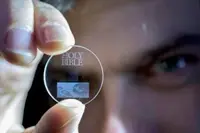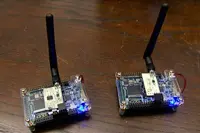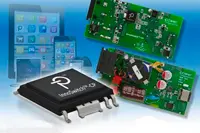Electronics News
Archive : 24 February 2016 год
 Scientists at the University of Southampton have made a major step forward in the development of digital data storage that is capable of surviving for billions of years.
Scientists at the University of Southampton have made a major step forward in the development of digital data storage that is capable of surviving for billions of years.
Using nanostructured glass, scientists from the University’s Optoelectronics Research Centre (ORC) have developed the recording and retrieval processes of five dimensional (5D) digital data by femtosecond laser writing. The ultrafast laser produces extremely short, intense pulses of light and writes the files in three layers of nanostructured dots separated by 5µm.
The data is recorded via self-assembled nanostructures created in fused quartz. The five dimensional recording of information is achieved through the size and orientation of the nanostructures as well as the three dimensional positions of the nanodots.
The self-assembled nanostructures change the way light travels through glass, modifying polarisation of light that can then be read by combination of optical microscope and a polariser, similar to that found in Polaroid sunglasses.
The storage allows unprecedented properties including 360TBytes disc data capacity, thermal stability up to 1000°C and virtually unlimited lifetime at room temperature - 13.8billion years at 190°C. The researchers claim that this is a stable and safe form of portable memory that could be useful for organisations with big archives, such as national archives, museums and libraries, to preserve their information and records.
Major documents from human history such as Universal Declaration of Human Rights, Newton’s Opticks, Magna Carta and Kings James Bible, have been saved via this method as digital copies that could survive the human race.
Professor Peter Kazansky, from the ORC, says: “It is thrilling to think that we have created the technology to preserve documents and information and store it in space for future generations. This technology can secure the last evidence of our civilisation: all we’ve learnt will not be forgotten.”
The team are now looking for industry partners to further develop and commercialise this technology.
Author
Tom Austin-Morgan
Source: www.newelectronics.co.uk
 A team of computer scientists and electrical engineers from the University of Washington claims to have generated Wi-Fi transmissions using 10,000 times less power than conventional methods. The Passive Wi-Fi system is also said to consume 1000 times less power than existing energy-efficient wireless communication platforms, such as Bluetooth Low Energy and Zigbee.
A team of computer scientists and electrical engineers from the University of Washington claims to have generated Wi-Fi transmissions using 10,000 times less power than conventional methods. The Passive Wi-Fi system is also said to consume 1000 times less power than existing energy-efficient wireless communication platforms, such as Bluetooth Low Energy and Zigbee.
The team’s Passive Wi-Fi can is claimed to transmit Wi-Fi signals at bit rates of up to 11mbit/s that can be decoded on any of the billions of devices with Wi-Fi connectivity. These speeds are lower than the maximum Wi-Fi speeds but 11 times higher than Bluetooth.
To achieve these low-power Wi-Fi transmissions, the team decoupled the digital and analogue operations involved in radio transmissions. Over the last 20 years, the digital operations have become extremely energy efficient, but the analogue components still consume a lot of power.
The Passive Wi-Fi architecture assigns the analogue, power-intensive functions - like producing a signal at a specific frequency - to a single device in the network that is plugged into the wall.
An array of sensors produces Wi-Fi packets of information using low power by reflecting and absorbing that signal using a digital switch. In real-world test conditions, the team found the passive Wi-Fi sensors and a smartphone can communicate even at distances of 100ft.
"All the networking, heavy-lifting and power-consuming pieces are done by the one plugged-in device," explained co-author Vamsi Talla, an electrical engineering doctoral student. "The passive devices are only reflecting to generate the Wi-Fi packets, which is a really energy-efficient way to communicate."
Because the sensors are creating actual Wi-Fi packets, the researchers say they can communicate with any Wi-Fi enabled device right out of the box without any additional specialised equipment. The technology could enable types of communication that haven't previously been possible because energy demands have outstripped available power supplies.
Joshua Smith, UW associate professor of computer science and engineering and of electrical engineering, concluded: "Now that we can achieve Wi-Fi for tens of microwatts of power and can do much better than both Bluetooth and ZigBee, you could now imagine using Wi-Fi for everything."
The technology has been named one of the 10 breakthrough technologies of 2016 in the MIT Technology Review.
Author
Tom Austin-Morgan
Source: www.newelectronics.co.uk
 Power Integrations and Cypress Semiconductor have announced a joint reference design describing a 20W, USB-PD compliant AC/DC power converter targeted at chargers for smart mobile devices. The design, titled DER-533, pairs the EZ-PD CCG2 USB Type-C port controller from Cypress with Power Integrations’ InnoSwitch-CP off-line CV/CC flyback switcher IC, enabling designers to produce a standards-compliant power adapter that is claimed to be fast, compact and energy-efficient.
Power Integrations and Cypress Semiconductor have announced a joint reference design describing a 20W, USB-PD compliant AC/DC power converter targeted at chargers for smart mobile devices. The design, titled DER-533, pairs the EZ-PD CCG2 USB Type-C port controller from Cypress with Power Integrations’ InnoSwitch-CP off-line CV/CC flyback switcher IC, enabling designers to produce a standards-compliant power adapter that is claimed to be fast, compact and energy-efficient.
Shyam Dujari, director of marketing for Power Integrations, said: “USB-PD will be the flexible power delivery vehicle for the next generation of mobile devices; it provides a unifying architecture for power and data within a slim, reversible and robust connector.”
Ganesh Subramaniam, senior director of the USB product line at Cypress, added: “Charger ubiquity and Type-C adoption will lead to USB-PD being implemented rapidly in power adapters for laptops, tablets and phones as the preferred technology choice for protocol-driven, fast-charging adapters.”
Cypress’ EZ-PD CCG2 USB Type-C port controller is said to comply with the latest USB Type-C and USB-PD standards and provides a complete solution for passive Electronically Marked Cable Assembly (EMCA) cables, active EMCA cables, notebooks, power adapters, monitors, docks and cable adapters. EZ-PD CCG2 reduces BOM by integrating a Type-C transceiver, termination resistors and system-level ESD.
By providing a constant power output, InnoSwitch-CP is claimed to allow battery-operated devices to draw up to the maximum power of the charger at any selected output voltage, optimising charge time and cost. InnoSwitch-CP ICs use Power Integrations’ FluxLink technology, eliminating the need for an optocoupler and enabling secondary-side control that delivers transient performance, CV/CC regulation and low no-load power consumption. It is also said to implement safe synchronous rectification, resulting in an efficient power supply.
DER-533 implements Profile 2 of the USB-PD standard and is capable of 5V/3A and 9V/2.2A of power delivery over a standard 3A USB Type-C cable.
Author
Tom Austin-Morgan
Source: www.newelectronics.co.uk

